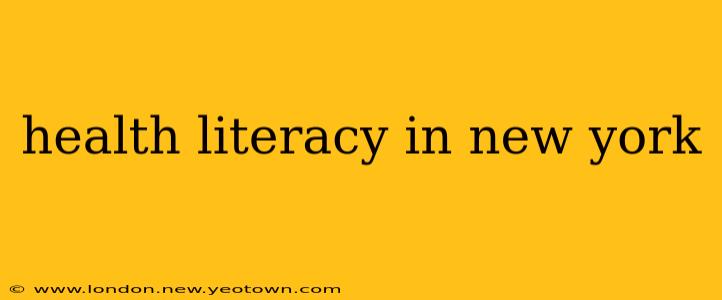New York, a bustling hub of diversity and innovation, also faces significant challenges in ensuring its residents have the health literacy skills they need to thrive. Health literacy, simply put, is the ability to understand and use health information to make informed decisions. It's not just about reading a doctor's prescription; it's about understanding the implications of that prescription, navigating the healthcare system, and advocating for your own health. This isn't just a problem for some; it affects people across socioeconomic backgrounds, ethnicities, and ages, impacting access to quality care and overall health outcomes.
What is Health Literacy and Why Does it Matter in New York?
Imagine trying to understand a complex medical bill, decipher confusing insurance forms, or communicate effectively with a healthcare provider who uses technical jargon. These are everyday challenges for many New Yorkers, highlighting the crucial role of health literacy. Without adequate health literacy, individuals may:
- Delay or forgo necessary medical care: Confusion about symptoms, treatment options, or the cost of care can lead to delayed or avoided medical attention, resulting in worsening health conditions.
- Experience difficulty managing chronic conditions: Understanding medication regimens, following dietary restrictions, and adhering to treatment plans requires strong health literacy skills. Lack of these skills can lead to poor management of chronic diseases like diabetes or hypertension.
- Face disparities in healthcare access and quality: Individuals with low health literacy may struggle to navigate the complexities of the healthcare system, leading to unequal access to quality care. This is particularly true for vulnerable populations.
- Contribute to higher healthcare costs: Poor health literacy can lead to more hospitalizations, emergency room visits, and complications, ultimately increasing healthcare costs for both individuals and the system as a whole.
How Does Health Literacy Affect Different Groups in New York?
H2: What are the biggest challenges faced by low-income New Yorkers in accessing healthcare information?
Low-income New Yorkers often face a double whammy: limited health literacy and limited access to reliable health information. They may lack internet access, rely on public transportation with limited schedules, and struggle to find time off work for appointments. This makes navigating the healthcare system incredibly difficult, leading to delays in care and poorer health outcomes. Additionally, the language barrier plays a significant role, as many low-income communities have a high concentration of non-English speakers.
H2: How does language impact health literacy in New York City?
New York City is a melting pot of languages, and language barriers significantly impact health literacy. Even if an individual is literate in their native language, translating medical terminology and navigating culturally specific health beliefs can be extremely challenging. Limited access to interpreters and culturally competent healthcare providers further exacerbates this issue.
H2: What resources are available in New York to improve health literacy?
New York offers a variety of resources aimed at improving health literacy. Many community health centers and hospitals offer health education programs, workshops, and materials in multiple languages. State and city health departments also provide valuable information and resources online and through community outreach programs. Furthermore, numerous non-profit organizations are dedicated to improving health literacy through targeted interventions and community-based initiatives.
Improving Health Literacy in New York: A Collaborative Effort
Addressing health literacy in New York requires a multi-pronged approach. This includes:
- Investing in culturally and linguistically appropriate health education programs: Programs must be tailored to the specific needs and cultural contexts of diverse communities.
- Expanding access to reliable health information: This involves bridging the digital divide and ensuring access to information in multiple languages and formats.
- Training healthcare providers in effective communication skills: Providers need to be trained to communicate complex medical information in a clear, concise, and understandable manner.
- Empowering patients to advocate for their own health: Individuals need to be equipped with the skills and confidence to ask questions, communicate their needs, and actively participate in their healthcare decisions.
Improving health literacy in New York is not simply about providing information; it’s about building a healthcare system that is accessible, equitable, and empowers individuals to take control of their health and well-being. This is a continuous journey, requiring collaborative efforts from healthcare providers, community organizations, policymakers, and individuals themselves. Only through this united front can we ensure that all New Yorkers have the opportunity to live long, healthy, and fulfilling lives.

